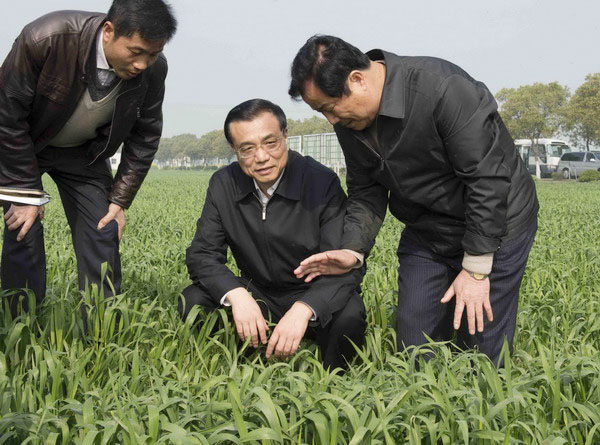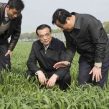
Li Keqiang, New Type Urbanist
Publication: China Brief Volume: 13 Issue: 19
By:

Since coming into office in late 2013–early 2013, Chinese Premier Li Keqiang has staked out political territory as an advocate of economic reform. His signature policy initiative is a “new type of urbanization,” described by Xinhua as an effort to boost consumption by getting local governments to invest in environmental protection and social services and to control the price of housing (Xinhua, August 23 and 27, September 7).
Urbanization is a theme that Li has stressed throughout his career: his doctorate, completed in the early 1990s at Beijing University, was on the transition between agricultural and urban economies in China. “The reality of modernization in fact is to see traditional agricultural society change to industrial society,” he wrote then, continuing, “The main challenge for China’s transition is the modernization of the 80% of its population that still lives in the rural areas” (Li Keqiang, “Lun Wo Guo Jingji de San Yuan Jeigou,” page 65). Two decades later, in speeches published in the Party’s theoretical magazine, Li spoke of the need to find “new spaces for growth” (Seeking Truth, 2009, No. 15). These included raising consumption, lowering capital investment as a proportion of GDP, increasing the service sector’s role in the economy and deepening urbanization. The four great structural adjustments are now his responsibility, but it is the last of these, urbanization, that has become the theme about which he has spoken most since becoming premier in March 2013.
Li has emphasized that the new type of urbanization is not the same as the old type. On August 30, he met with a group of experts at the Zhongnanhai leadership compound to discuss the challenges of urbanization. He reportedly told them that urbanization policy should “put people at the core,” addressing the inequality between registered urban residents and migrant workers in access to social services, education and housing (People’s Daily Online, September 10). He criticized local governments for relying on overinvestment in real estate to drive growth, and on land sales to fund their budgets (Xinhua, September 7). The Xinhua coverage singled out for criticism the city of Erdos, which has become a symbol of overinvestment as real estate speculators drove the construction of an almost-uninhabited ghost city. It also quoted an expert with the State Council-run Chinese Academy for Governance, Wang Xiaoguang, saying that “Local governments should abandon the mentality of pursuing urbanization for driving up investment and stabilizing growth in the short term.”
It is clear that new type urbanization lies at the heart of the further economic growth potential that Li referred to on his visit to the Guangxi Autonomous Region in June this year. “Growth,” he stated in Guangxi, “creates the conditions for restructuring, while restructuring in turn unleashes further economic growth” (Xinhua, June 10). Urbanization, as a Xinhua profile of Li issued on March 16 made clear, “is the biggest source of development.” So it is Li’s key to solving the Party’s longstanding dilemma between short-term growth and long-term rebalancing—a way of reducing China’s reliance on state-led investment without the risk of a politically perilous recession.
Li’s technocratic style sets him apart from President Xi Jinping. While Li has been the reassuring face of stable economic growth, appearing at the Davos Summer Forum in Dalian to tell international investors not to worry about China (Xinhua, September 16), Xi has cut a fearsome figure, declaiming loudly about the China Dream and evoking Mao Zedong to spur the Party to get its house in order and rein in corruption. Recently, he has spent much of his time overseeing an educational campaign to root out “four bad work styles,” making regular appearances at provincial educational meetings to hear reports on the process of self-criticism, most recently appearing at a Hebei Party meeting to emphasize that “criticism and self-criticism are powerful weapons for resolving contradictions within the Party” (Xinhua, September 25). These are highly political themes, concerning the moral health of the Party, and the way in which it appeals to people across society as China aspires to become a middle income country with great power status.
While there is a considerable gap in tone, Xi and Li are playing different roles in what is in fact a single political project to restore some of the Party’s tarnished moral authority and strengthen its right to rule—a project which depends heavily on economic stability. As premier, and thus head of the apparatus of government, Li’s job is to articulate and then deliver specific policy, using the State Council’s power to write regulations and allocate budgets. Xi, as Party Secretary, has to be mobilizer and motivator in chief using the tools of the Party, the most potent of which are ideological campaigns and the Party’s internal discipline system. While his focus is elsewhere, he has echoed Li’s call for economic reform, making a speech about the issue in July in Hubei: “To address the series of problems and challenges facing our country’s development, the key is to deepen reforms in all aspects” (Xinhua, July 23). Simply put, as the chief manager of the economy the premier holds most of the carrots and is responsible for setting policy directions, while the Party secretary holds most of the sticks and is responsible for maintaining the control needed to make sure policies are implemented.
Changing China’s urbanization model is going to be a hard task, however; and within the Party Li has a poor reputation for getting things done. In his provincial leadership career in the late 1990s and early 2000s, Li was associated with a number of problems: from the handling of the compensation claims over the AIDS contaminated blood crisis in Henan as Party Secretary there, to a series of large scale fires in public buildings in Liaoning. “Look at his record,” one unnamed senior executive interviewed by the Financial Times stated in March 2013, “and you will know he has a serious problem with execution” (Financial Times, March 22).
As Xinhua observes, the biggest challenge is likely to be local governments. Li’s plans for rebalancing will require them to swallow the bitter pill of swapping lucrative land deals for costly social welfare programs:
Increasing the value of land through expropriation and population aggregation has been the most effective way for local authorities to attract investment and grow the local economy over the past years, a great incentive to boost urbanization (Xinhua, August 23).
So far, early indications out of the State Council suggest that New Type Urbanization may leave local governments with plenty of opportunities to continue the cycle of land seizures and infrastructure investment. A ruling issued on September 16 called for increased investment in transportation, utilities pipelines, sewage treatment and garbage disposal, and ecological parks and gardens. This last in particular is a red flag—Chinese local governments have a history stretching back to the 90s of seizing more land than they need for recreational facilities in order to profit from the rise in land values associated with them.
The political risks are clear; a China where most people live in urban areas will be one where governance will have to be reconfigured and restructured so that it can accommodate this immense change. Cities like Shanghai already have to accept half a million new residents a year. Social welfare, education and other public goods have to be supplied, putting further strain on local budgets already heavily reliant on bank debt. Resolving this may require more of the power of taxation to be devolved back to cities, a stronger argument for these new mega-metropolises to become much more autonomous.
There is also the social dimension. Rapid urbanisation taking China toward a level of 60% or more living in cities by the end of the decade will inevitably involve profound social change. Chinese society is already hugely liquid, with over 200 million migrants working away from their home place according to the national census in 2010. This vast mobile army is frequently the victim of prejudice and suffers insecurity though lack of easy access to public goods. As a result, it is frequently the source of protests. Even more people will leave environments and communities they have some family or historic connection with and live in places created almost overnight. As many other societies that went through this process on a much smaller scale in Europe and elsewhere know, this is a hugely disorientating process and one that carries high risk. Is China really ready for this kind of urbanizing revolution?





